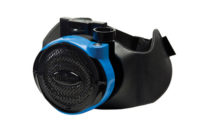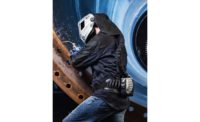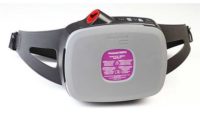Airflow: The flow of filtered air into the hood creates a positive pressure and keeps the contaminants out. For hood-style PAPRs, NIOSH requires at least 6 CFM (Cubic feet per minute) or 170 LPM (Litre per minute) and 4.0 CFM or 115 LPM but most workers usually want significantly more airflow than that. Be sure to ask for the airflow specifications of any PAPR you are considering.
Assigned Protection Factor (APF): This is OSHA’s terminology for the level of protection a respirator or class of respirators delivers to the wearer. Here are the APFs:
- Half Mask PAPRs = 50 APF
- Full Face PAPRs = 1,000 APF
- Loose-Fitting Facepiece PAPRs = 25 APF
- Loose-Fitting Hoods/Helmet PAPRs = 25 APF (unless the employer obtains data from the manufacturer to support 1,000 APF, usually obtained from a simulated workplace protection factor study)
To determine the APF required for your application, have the concentration of the contaminant measured in the work environment and then divide this concentration by the PEL (Permissible Exposure Limit). Many applications with loose-fitting hoods require more than 25 APF, so it’s important to choose a manufacturer that can provide the supporting data for 1,000 APF.
Air Filtration: The filter cartridge of your PAPR must be selected properly to match the requirements of the airborne contaminants of your application. Some PAPRs only have particulate (HEPA) filters and therefore cannot be used in Organic Vapor, Acid Gas, Ammonia, or Formaldehyde applications.
Alarms: When you use a cell phone, you know how much signal and how much battery you have. Depending on the PAPR you choose, you can know your airflow, the proper setpoint, and the status of your battery at all times. This gives you peace of mind when you might be entering a work environment where you are going to depend on your PAPR for the next 4-8 hours.
Batteries: There are many technologies to choose from including Alkaline, Lead Acid, NiMH, NiCd, and Lithium Ion. Each technology has significant differences. For example, the Lithium Ion battery offers the most capacity with the least amount of weight without risking “memory” issues. NiCd batteries can be prone to “memory” issues and are one of the heavier technologies, but if proper maintenance is performed can deliver the most charge/discharge cycles over the course of the product’s life.
Balance: Weight is a good specification to check off on paper, but the perception of how heavy a product is will depend on its ergonomic design and balance. Some PAPRs offer a contoured belt to evenly distribute the weight, while other PAPRs have external batteries with cables connecting them to the blower unit, which can create an imbalance and a potential snag hazard.
Appearance: Over the last several years, industrial psychologists have educated safety managers on how stylish PPE can help with compliance. One of the most obvious examples is safety glasses. In the past, safety glasses were big, boxy and, let’s face it, very unattractive. Now they come in designer styles and are sleek, fashionable and comfortable and much easier to convince a worker to wear. The same holds true with PAPRs. When the product looks good, it is more likely to be worn and taken care of properly.
Chargers: If you have a battery, then you almost certainly have a charger. While charger technology has come a long way, not all chargers are the same. Chargers have been very basic and require the user to remove a battery after a specific length of time. Then technology evolved and “smart chargers” were introduced. These chargers sense when the battery is almost full and change the charge algorithm from rapid charge to trickle charge. Some even monitor for temperature as batteries can be damaged if they stay too warm for too long.
In addition, one must consider how many batteries and chargers are required in order to plan for space requirements. Some PAPRs only offer single chargers, while others offer gang chargers with up to six ports providing great space savings. Finally, some chargers can offer diagnostic capabilities with information such as the number of cycles charged/discharged, serial number, date manufactured, time to charge, present capacity, present voltage, and expected capacity when full.
Comfort: The modern worker increasingly demands comfort in PPE. Comfort is greatly enhanced by balance and airflow, which we have already mentioned. Headtops are also a great piece of the comfort puzzle.
Confidence: Let’s face it, if there weren’t any hazards you wouldn’t be considering a PAPR. You are relying on this device to ensure you stay safe and free from developing a chronic illness in later years. It’s important for you to have confidence in your equipment. Is the product NIOSH approved? Is there APF data? Are there alarms to warn you of changing conditions? Does the company have a proven track record? Be sure to check customer references and investigate thoroughly these issues so you can have confidence in the product you select. Just remember your ABCs.



